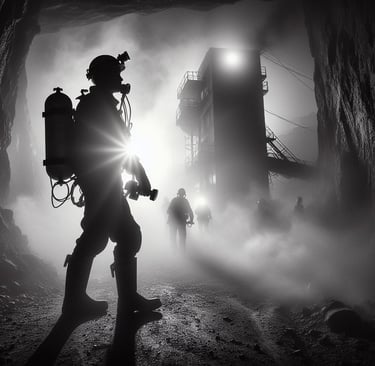The Role of Mine Emergency Response Teams
A crucial aspect of this preparedness is the presence of Mine Emergency Response Teams (ERTs). These teams play a pivotal role in responding to various emergency incidents within mining sites, ensuring the safety and well-being of miners.
Brandon Crotts
2/13/20242 min read


In the dynamic environment of mining operations, emergencies can arise unexpectedly, making preparedness essential. A crucial aspect of this preparedness is the presence of Mine Emergency Response Teams (ERTs). These teams play a pivotal role in responding to various emergency incidents within mining sites, ensuring the safety and well-being of miners.
What is a Mine Emergency Response Team?
A Mine Emergency Response Team, or ERT, is a specialized group of individuals trained to prepare for and respond to emergencies in mines. These emergencies can range from fires and explosions to roof collapses and chemical spills. The primary objective of an ERT is to mitigate risks, protect lives, and minimize the impact of emergencies on personnel and property.
Regulatory Framework
The regulatory framework governing mine safety involves two primary agencies: the Mine Safety and Health Administration (MSHA) and the Occupational Safety and Health Administration (OSHA). MSHA sets specific standards and regulations tailored to mine safety, while OSHA oversees broader workplace safety standards that also apply to mining operations.
Training and Certification
Comprehensive training is essential for equipping ERT members with the skills and knowledge to effectively handle emergencies. Both MSHA and OSHA recognize specific certification programs tailored to mine emergency response teams, ensuring competency in areas such as confined space rescue, mine rescue, and hazardous materials handling/response.
Equipment and Resources
ERTs rely on specialized equipment and resources to carry out their duties effectively. This includes personal protective gear, communication devices, rescue tools, and emergency response vehicles. Having access to the right equipment is crucial for ensuring the safety of responders and the success of rescue operations.
Emergency Response Protocols
Structured emergency response protocols are essential for guiding ERTs during various emergency situations. These protocols cover aspects such as initial assessment and communication, evacuation procedures, search and rescue operations, and medical response and triage. Clear and concise protocols help streamline response efforts and minimize confusion during emergencies.
Drill and Exercise Programs
Regular emergency response drills are vital for maintaining readiness and validating procedures. Drill programs should be diverse, realistic, and tailored to address specific hazards encountered in mining operations. Examples of drill scenarios may include simulated mine fires, roof collapses, machinery accidents, and hazardous material spills.
Continuous Improvement
Ongoing evaluation and feedback mechanisms allow for continuous improvement of emergency response procedures, training programs, equipment effectiveness, and coordination efforts. Lessons learned from drills and real-life incidents should be systematically analyzed and implemented to enhance overall preparedness and response capabilities.
Legal Compliance
Employers have a legal obligation to ensure that ERT members are properly trained, certified, and compliant with regulatory requirements. Certification provides assurance that responders meet established competency standards and can perform their roles effectively, reducing the risk of legal liability in the event of emergencies.
In conclusion, Mine Emergency Response Teams play a critical role in ensuring safety and compliance within mining operations. By adhering to regulatory standards, receiving comprehensive training, and having access to the necessary equipment and resources, these teams are well-equipped to respond to emergencies effectively and protect the lives of miners.














